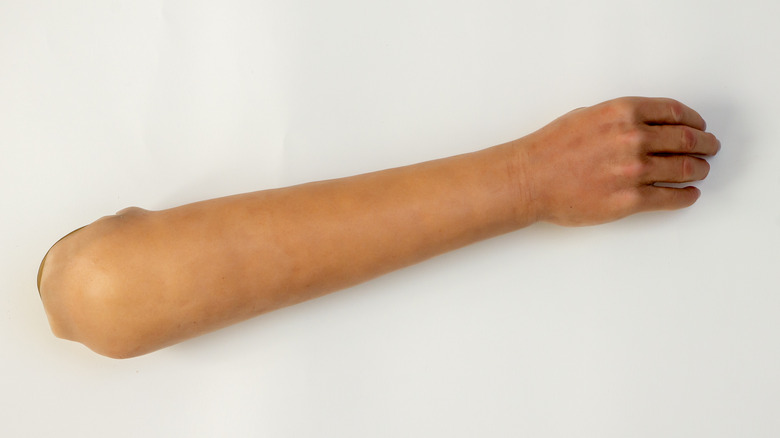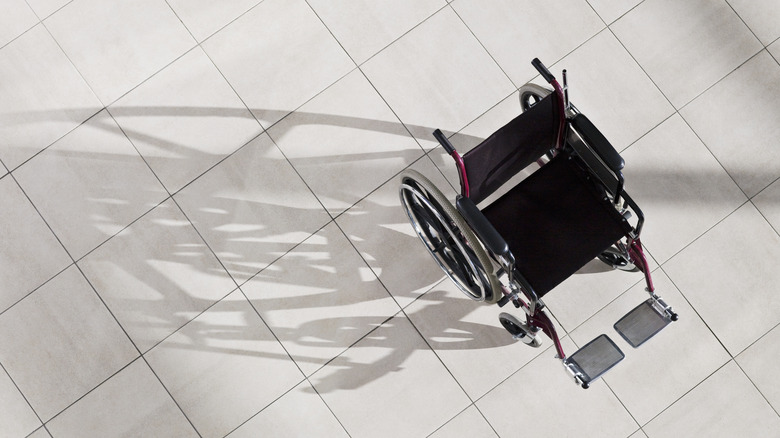The Disorder That Drives People To Sever Their Own Limbs
Imagine looking down at your body — your legs, your arms, your hands, your toes — and seeing foreign objects that don't belong to "you." You have no sense of ownership over them, and they're no more connected to your fundamental physical self than separate, detachable things like chairs, socks, or coffee mugs. In fact, these foreign, alien objects cause you so much distress, anxiety, and horror that you've just got to get rid of them.
It might be hard to imagine, but this is what people experiencing body integrity identity disorder (BIID), aka body integrity dysphoria (BID), go through every day. It's only got wider attention within the past few decades — and even then not much. As The Guardian overviews, the disorder first shows up in print a scant 238 years ago in 1785, when an English patient threatened French surgeon Jean-Joseph Sue at gunpoint to cut off one of his legs because he'd fallen in love with an amputee and wanted to woo her by losing a limb. Formerly known as apotemnophilia and thought to be a sexual fetish, BIID is now recognized as a congenital neurological disorder with no current treatment or cure.
Misdiagnosed as a sexual disorder
As mentioned, body integrity identity disorder (BIID) was previously classified as a sexual disorder and given the name "apotemnophilia." Specifically, it was described as a type of "paraphilia," an aberrant sexual preference like necrophilia, pedophilia, zoophilia, and so forth. In other words, it was believed that people who wanted healthy limbs severed, healthy eyes destroyed, healthy hearing eradicated, etc., wanted so because it provided them with some kind of sexual gratification. Granted, this might have roots in the initial 1785 story about the Englishman who held up surgeon Jean-Joseph Sue at gunpoint.
However, The New York Times says the term "apotemnophilia" was first coined in 1977 by psychologist and sexologist John Money. It appeared in a paper he wrote with Russell Jobaris and Gregg Furth that was published the same year in "The Journal of Sex Research." There's lots of different takes on Money's motivations and research, which is a colossal story in and of itself. According to his obituary in The Times, "He argued that social and environmental cues interacted with a child's genes and hormones to shape whether the person identified as male or female." But in the end his career was tainted after he conducted unethical experiments to prove his theories, and his patient and subject — David Reimer — accused him of sexual abuse, later dying by suicide, as Daily Mail relates. In other words, Money's assessment of BIID as a type of paraphilia seems to have stemmed from his own preoccupations. It took over 20 years for apotemnophilia to get reassessed by Scottish surgeon Robert Smith in the late '90s as a neurological disorder, per News Medical.
The trauma of a 'wannabe' body
The road body integrity identity disorder (BIID) took from misdiagnosed sexual disorder to neurological disorder was strewn with self-severed limbs, clandestine surgeries, and the rise of online support groups. Surgeon Robert Smith performed two elective surgeries in 1997 and 1999 on individuals experiencing BIID before his hospital, Falkirk Royal Infirmary, shut things down. By 2004, Dr. Michael First of Columbia University had performed a one-on-one, discrete phone survey with 52 individuals — nine of already had amputations, and the rest wanted them. First deemed BIID a type of body dysmorphic disorder characterized by an obsessive criticism of one's physical appearance. Dr. David Spiegel of Stanford University analogized BIID to anorexia nervosa, a disorder involving distorted perception about one's weight. In the case of BIID, the dysmorphic element comes from a dissociation between one's "self" and one's appendages.
Meanwhile, those with BIID continued to seek relief. Back in 1968 cricket historian Rowland Bowen sat down in his bathtub one day with a hacksaw, hammer, and chisel and removed his right leg, as The Guardian describes. In 1998, per The Atlantic, someone traveled to Mexico to pay $10,000 for a black market amputation and died of gangrene in his motel. Homemade guillotines, shotguns, hacksaws, cigar cutters, even exposing a limb to dry ice for hours: People have done all these and more. They even connected through online discussion groups composed of thousands of "wannabes," the name people with BIID gave themselves.
Parietal lobe damage
Within the past 15 years researchers have pinpointed a specific neurological cause of body integrity identity disorder (BIID), if not a treatment or cure. A 2012 medical article published on PLOS One found that individuals experiencing BIID reported feeling dissociated from some certain body part since childhood, indicating that the disorder is congenital, i.e., the result of a birth defect. A 2016 article in PLOS One indicated that damage to the brain's parietal lobe resulted in a mismatch between the brain's internal body map and a person's actual, physical body. One instance of someone who suffered from a stroke described the person asking for "that strange leg" to be removed from the bed.
This kind of insight provides researchers and those with BIID a roadmap toward permanent care solutions in the future. In the meantime, there's minimal relief to be found. As WebMD outlines, cognitive behavior therapy can help alleviate symptoms to a degree, as can antidepressants. However, nothing can fully remove the desire to remove a healthy limb — nothing short of amputation. And yet, for those with BIID, this is typically the desired option. "My eyes were screaming and I had some drain cleaner going down my cheek burning my skin," Jewel Shuping, who has BIID, said in 2015 on the Daily Mail. "But all I could think was 'I am going blind, it is going to be okay.'" She has no regrets, and has never been happier.
If you or someone you know needs help with mental health, please contact the Crisis Text Line by texting HOME to 741741, call the National Alliance on Mental Illness helpline at 1-800-950-NAMI (6264), or visit the National Institute of Mental Health website.
If you or someone you know may be the victim of child abuse, please contact the Childhelp National Child Abuse Hotline at 1-800-4-A-Child (1-800-422-4453) or contact their live chat services.
If you or someone you know is struggling or in crisis, help is available. Call or text 988 or chat 988lifeline.org.



